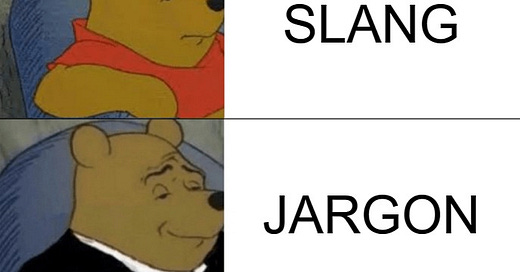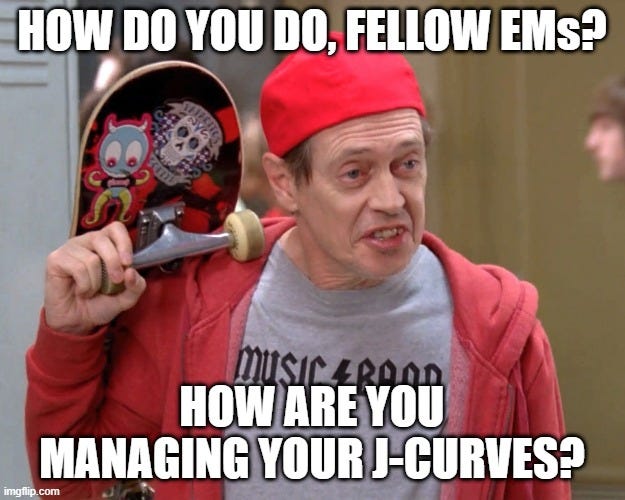Key Takeaways: Jargon is formal slang. Jargon uses technical terms but its primary purpose is to show status. The more jargon someone uses, the lower their status and credibility.
What is jargon?
We will start with a formal definition:
Jargon is (1) socially learned words or expressions used by a particular profession or specialized group, (2) which are used in place of more broadly accessible and less formal alternatives, and (3) are difficult for outsiders to understand.1
What if we compare that definition to slang?
Slang is “very informal words and expressions typically restricted to a particular group of people.”2
Jargon Is Formal Slang
Jargon is basically formal slang. It's socially learned language that’s difficult for outsiders to understand. Jargon is used by professionals and workers in fields such as law, military, and venture capital. And like slang, jargon sends us social signals.
For example, if I say “clean up your cap table” or “did you diligence this?” it has surface-level meaning, but it also sends a signal to insiders in the venture industry.
What kind of a signal does jargon send?
First, jargon establishes group identity:
Second, jargon can signal a person’s status. That is, does this speaker have respect, prestige, pedigree, or social standing in their community?
The Nobel Laureate economist John Harsanyi said “apart from economic payoffs, social status seems to be the most important incentive and motivating force of social behavior.”3 Higher status individuals generally have more credibility. For many people, it matters less about what is said and more about who said it.
However, unlike slang, jargon incorporates an additional element: Formal industry speak, what researchers call “technical terms.”
Jargon Incorporates Technical Terms
Technical terms refers to specialized language used by a particular field or profession. Terms of art make it difficult for outsiders to understand but provide a practical way for insiders to communicate efficiently with each other.
Examples of Jargon
🚩 Military terms like “10-4” or “COPY THAT”
🚩 Buzzwords like “infra” or “tech stack”
🚩 Legalese or industry terms like “cram down” or “pay-to-play”
🚩 Acronyms like “MM” for million. “$10 million” is $10m or $10M, not $10MM
Acronyms can often be a form of jargon or technical terms.
For example, is this tweet “VC jargon” or just technical terms?

This has 32 technical terms packed into 260 characters. Let’s define them:4
GPs: “General partners” are the fund’s managers/managing directors
LPs: “Limited partners” are the fund’s investors
506B: “Rule 506(b)” is part of Regulation D, which requires funds to raise privately
506C: “Rule 506(c)” is also part of Regulation D, which allows funds to raise publicly
Form D: A form required to be submitted with the SEC in reliance on Reg. D
Schedule K-1: An IRS tax form issued every year by the fund to its investors
SEC: “Securities and Exchange Commission,” US securities enforcement agency
LPA: “Limited Partnership Agreement,” the fund’s investment agreement
IRA: “Investors’ Rights Agreement,” part of the NVCA Forms for venture deals
AUM: “Assets under management,” or the amount of capital managed by the GPs
MF: “Management fees,” an annual fixed fee paid by investors for fund operations
2/20: The industry standard fee structure of 2% management fee/year, 20% carry
DD: “Due diligence,” the process of verifying a potential investment
DR: “Data room,” files and folders uploaded for due diligence
SPV: “Special purpose vehicle,” entity setup to invest in 1+ companies or 1+ assets
Recycling: Money returned from an early exit and re-allocated to a new company
Reserves: Capital set aside for additional investments such as pro rata allocations
Carry: “Carried interest,” the percentage of profit paid to the General Partner
Drag: “Cash drag",” refers to cash on hand that’s not being invested in startups
Hold: “Cash hold",” refers to cash being held to pay for fees, expenses or reserves
Inflows: Cash coming into a company
Outflows: Cash going out of a company
Target IRR: “Internal Rate of Return” the fund aims to achieve for its investors
Gross IRR: “Internal Rate of Return” on the total return of the fund’s investments
Net IRR: Gross IRR after subtracting fees and expenses
MOIC: “Multiple of invested capital,” the value of investment relative to its cost
NPV: “Net Present Value,” a finance method used to compare deal profitability
RVPI: “Realized Value Per Investment” exit value ($) / total number of investments
DPI: “Distribution to Paid-In Capital,” the realization multiple for returns to investors. 1.67x DPI = investors receive 1.67 times their total investment in the fund (!)
TVPI: “Total Value of Paid-in Capital,” the same as MOIC after capital calls met, but before, TVPI will be greater than MOIC (Total Value / Paid in Capital)
RoI: “Return on Investment,” a measure of of profitability of an investment expressed as a percentage: (Net Profit / Total Investment) x 100 = %
CoC: “Cost of Capital,” minimum returns investors expect for providing capital
Jargon Is Slang + Technical Terms
Technical terms are a way to communicate information efficiently, while jargon incorporates elements of slang and technical terms:
If jargon overlaps with technical terms, how can you tell the difference between jargon and technical terms?
Jargon's primary purpose is not to convey information or express knowledge, but to flaunt status
Why should we care if someone is showing off or how certain words or phrases are seen as either “jargon” or “technical terms”?
Jargon Indicates Lack of Credibility
Overusing jargon has negative consequences. People who lack status are more likely to use jargon to compensate for their insecurities.
Jargon isn't a sign of expertise; it's a sign of insecurity. —Adam Grant
In 2020, Columbia Business School published a research paper which found that individuals with low status use jargon, acronyms, and legalese at higher rates than high-status individuals because they are more insecure about how they will be read. Individuals recognized as having higher status are less likely to use jargon because they are motivated primarily by effective communication and not just bolstering their public image.
The research paper reviewed nine studies total from over 64,000 dissertations and found that authors from lower-ranked schools used more jargon and acronyms in their Ph.D. dissertations and master's theses than those at higher-ranked schools. It also surveyed 1,100 participants finding that low-status individuals use more jargon because they want to impress their readers rather than make their words easier to understand.
“Jargon is like a suit, a car, or a watch – it’s a status symbol. Those who are insecure ‘dress up’ their words, believing it will make them appear smarter or cause others to take them more seriously… It’s ironic though, because the reality is that people secure in their high status use less jargon, acronyms, and legalese. They prioritize clear communication, rather than concerning themselves with status or public perception.” —Adam Galinsky, the Paul Calello Professor of Leadership and Ethics at Columbia Business School.5
As the research shows, the more jargon you use, the more likely that people will perceive you as having lower status, meaning your words are less credible. Which is probably why jargon-heavy tweets are so cringe.
For example, is this VC jargon or technical terms?


🚩 🚩 🚩 🚩 🚩 “EMs, Fund I-III (IV), Seed+, high var perf %”
It has all the hallmarks of jargon.
What are the common hallmarks of jargon?
The Five Hallmarks of Jargon
🚩 Using terms without fully understanding their meanings or concepts
🚩 Using difficult terms without concrete examples or good explanations
🚩 Using complex language to make simple concepts sound more sophisticated than they actually are
🚩 Using buzzwords to impress others without providing any real value or insight
🚩 Using terms to create the illusion of expertise or authority without having it
What about avoiding jargon?
Five Ways to Avoid Jargon
Understand the meaning and concepts behind terms before using them
Provide concrete examples and clear explanations for difficult terms
Keep language simple
Avoid buzzwords
Never use terms to show off—your words should add value
On my next article I will publish 10 key fund terms without the use of jargon.
Please reply if you have any fund formation terms you would like me to add to the list.
Subscribing to the Law of VC newsletter is free and simple. 🙌
If you've already subscribed, thank you so much—I appreciate it! 🙏
As always, if you'd like to drop me a note, you can email me at chris@harveyesq.com, reach me at my law firm’s website or find me on Twitter at @chrisharveyesq.
Thanks,
Chris Harvey
Zachariah Brown, Eric M. Anicich, and Adam D. Galinsky, Compensatory Conspicuous Communication: Low Status Increases Jargon Use, 161 Org. Behav. & Hum. Decision Processes 274 (2020).
See footnote #1, quoting the Oxford English Dictionary (2020).
Adam Waytz, "The Psychology of Social Status: How the pursuit of status can lead to aggressive and self-defeating behavior," Scientific American (2009).
Here are four glossaries will help guide you with venture capital terms:
1. Law of VC Database: Not a Glossary (2023)
2. Signature Block by Weekend Fund: Terms You Need to Know (2022)
3. VC Guide's Venture Vocab (2022)
4. SEC's Glossary: "Fund(amental)s" (2022)
Columbia Business School, People Who Lack Status Are More Likely to Use Jargon to Compensate for Their Insecurities, press release (2020).









